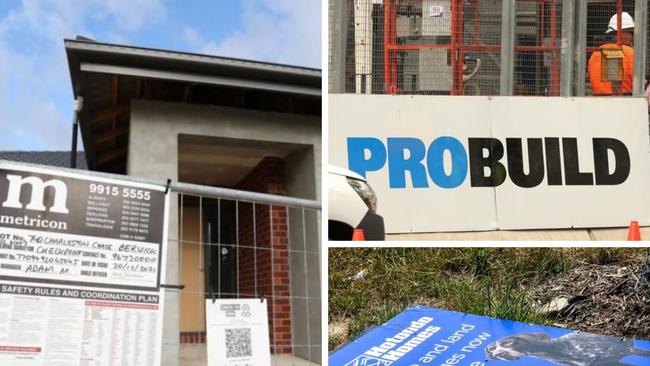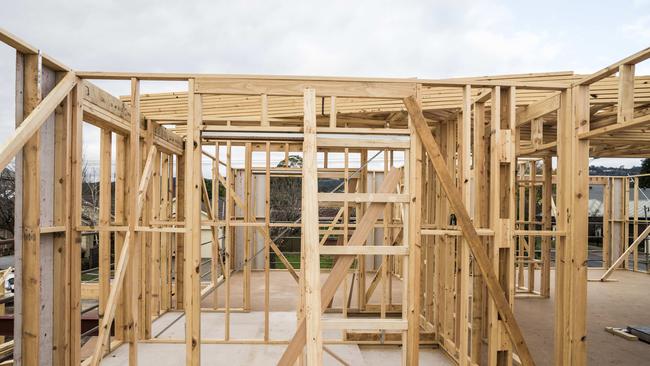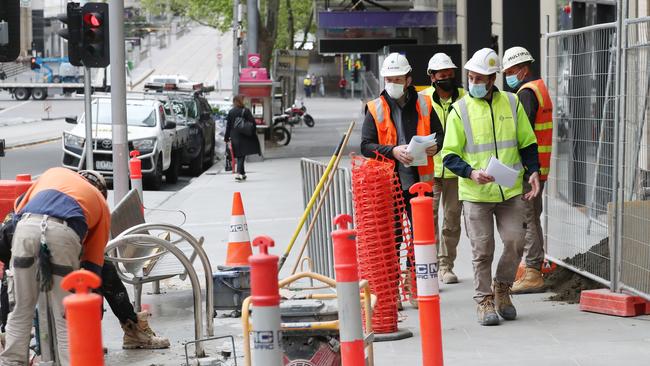Q&A: What is happening to the building industry?
Metricon is in crisis talks, while Probuild and Condev Construction have already collapsed. What is behind the building industry’s crisis?
Victoria
Don't miss out on the headlines from Victoria. Followed categories will be added to My News.
The nation’s building industry is being hit with a perfect storm as it weathers rising costs, fixed-price contracts and supply chain issues.
Major builders including Probuild and Condev Construction have already collapsed, while the nation’s biggest home builder, Metricon, will today hold crisis talks with the Victorian government.
So given there has been a housing boom, just what is going on?
Why are builders facing ruin?
A lethal mix of fixed-price contracts, surging costs and stretched supply chains.
Government stimulus rolled out during the pandemic fuelled a building boom.
But costs such as timber, steel and concrete have surged – timber and steel prices jumped 21 per cent and 45 per cent respectively in the year to March – driven by factors as diverse as international demand, floods in Queensland and the war in Ukraine.
Builders who have signed up to build homes on fixed-price contracts are now facing large losses as they deliver projects.

The signs your builder might be in trouble
Slowdowns, delays or missed deadlines can all be red flags.
Delays in payments to subcontractors or others in the supply chain or, more extreme, subcontractors refusing to go on-site should also be of concern.
“These signs indicate a company is struggling with its cash flow and it’s important to recognise them,” Andrew Spring, a construction insolvency specialist with Jirsch Sutherland, said.
“Monitoring project performance from tender to handover is essential in a time where many factors that are outside of a business’s control can impact a project’s financial success.”

What does the industry want?
Home builders locked into loss-making fixed-price contracts want more flexibility to increase them.
The Victorian government has so far resisted a push by the industry to allow them to pass on a jump in materials costs to customers.
In the meantime, builders have been reaching out to customers seeking to renegotiate fixed-price contracts by essentially asking the client to stump up more cash to have their home built.
What does Metricon say?
Metricon has repeatedly stressed it has a strong business and will be able to pay all suppliers on time.
It has also said it has a strong relationship with its banks has breathing space within all its loans.
It has also complained about being the victim of a rumour campaign that has sought to raise questions over the health of its business.
The privately owned company does not disclose its finances.
What could happen now?
Metricon will meet with state Treasurer Tim Pallas today.
The building giant has $195m in state government work and is all but certain to push for new conditions on that work to take in the higher cost environment.
The company is also understood to be seeking a fresh capital injection and is believed to have hired Sayers Group – an investment and consultancy firm headed by Carlton president Luke Sayers – to help chart a path forward.
Mr Sayers is a former PricewaterhouseCoopers executive with a deep contact book.
Business figures have also told the Herald Sun an international construction group has expressed interest in buying the company.

Is there anything the government can do?
Victorian Premier Daniel Andrews on Thursday said the government stood ready to provide support to Metricon.
“What we will consider is whatever Metricon comes to with us with,” Mr Andrews said.
“Let’s see what support they want and need and we will make assessments about what is appropriate to do.”
In a worst-case scenario Metricon falls under the state’s insurer the Victorian Risk Management and Insurance Authority.
It provides last-resort cover for homeowners when a builder goes bust, but homeowners who have had to rely on it have voiced frustration around delays in having their claims processed.
What happens when a big builder goes bust?
In the worst-case scenario if a company needs to enter insolvency is has two main avenues – voluntary administration or receivership.
In voluntary administration directions would call in an administrator to take over the running of the company and find a return for creditors.
Secured creditors – generally banks – and employees rank higher than unsecured creditors who, in the case of builders, include customers with homes being built or contracted to be built.
In this scenario the administrator would seek to rescue the business by essentially looking for another building group or developer to buy it.
But any rescue buyer is likely to ask customers to stump by extra cash – potentially tens of thousands of dollars – as part of its buyout deal to ensure it is not buying loss-making projects.

Any such deal would be presented to creditor in what is called a Deed of Company Arrangement.
While customers rank lower than secured creditors, a so-called DOCA needs to be approved by both a majority in the number and dollar value of creditors, meaning customers should have some power over accepting or rejecting any deal and shaping the terms they are offered.
Creditors in the Grocon administration repeatedly pushed for, and received, better final terms.
If a deal is not struck or approved the company can be placed into liquidation where it would essentially be sold off in a fire sale, an outcome unlikely to generate a better return for any class of creditor.
Receivership involves a secured creditor – think the bank – forcing a company into insolvency by appointing a receiver.
A receiver’s focus is to collect and sell enough secured assets to repay the debt owed to the secured creditor.
This option places customers in a weaker position than if the company entered voluntary administration.
But to repeat – Metricon has stressed it has a solid business and there is no current indication they need to go down this path.
I”m a Metricon customer. What should I do?
Don’t panic — but keep an eye on developments.
The Victorian Building Authority, Consumer Affairs Victoria and Victorian Risk Management and Insurance Authority all provide specific advice on what to do if your builder goes bust.





